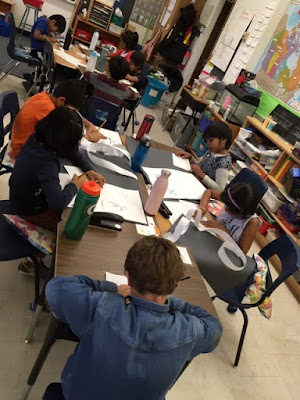




The last week of school for 2019 was a busy one! The children counted the hundreds of dollars donated to the Daily Bread Food Bank, learned the history of many holiday songs, created large winter-themed paintings and even learned about the Roman Numerals number system.
Math: The children had a quick lesson about Canadian currency and how to count money using their skip-counting skills. Then they applied their knowledge to our Food Bank project to count all the collected money. First, the money has to be sorted into groups of the same types of coins and bills. Then we skip counted the amounts of the different groups and recorded the amounts in a chart. Finally, the students used their calculator skills to add up the total. We were still receiving money even on Friday, so the grand total was $860.44! Well done!
The children preactised reading aloud large numbers and also used their calculator skills each day this month to calculate the next term in our increasing doubles pattern. We started with "1" on December 1st and when the number is doubled each day (1,2,4,8...) on the the twentieth day or December 20th, the number was 524, 288! If we had continued to the end of the month, on the 31st the number would be 1,073,741,824 or over one billion! Ah...the power of doubling numbers!
The class also practised solving addition and subtraction questions with regrouping. (This is a skill that must be practised so that the process becomes automatic.)
The class also had some fun playing BINGO this week. BINGO is a great game to practise quickly recognizing two digit numbers and horizontal, vertical and diagonal lines.
The class finally had some time to learn about the Roman Numeral number system. In our classroom, we use Roman Numerals each day to write the date. For example, December 20, 2019 can also be written 20 XII 19. The children can read and write Roman Numerals to 12 or XII. Also, the students now know how to write the year 2019 = MMXIX and 2020=MMXX.
Writing: This last week of school, there were no new spelling words as the class spent some time reviewing the word wall words learned so far, with an emphasis on homophone word pairs. For example, we played the guessing game, "I'm Thinking of a Word Wall Word" and solved word wall word search puzzles (even one containing the student's names).
The children reflected on what they have learned so far this year in class and then wrote about it, making sure to write their sentences correctly.
Social Studies: The children learned about the traditions of some of the different holidays at this time of year. Christmas (December 25) is celebrated by Christians and there are religious aspects (birth of Jesus) and non-religious aspects (Santa and Christmas trees). Hanukkah (December 22 - evening) is celebrated by Jewish people and lasts for eight days. The first day of winter (December 22) is also called the Winter Solstice and is based on the placement of the Earth in its orbit around the sun. Its also the day with the shortest amount of daylight hours. We also talked about the traditions around New Year's Eve celebrations...even using "party horns" to announce "Happy New Year" when the clock strikes twelve midnight.
Reading: The class learned about some songs that are popular at this time of year. They read the words to several songs. These words are called "lyrics" and are a type of poem. The students practised recognizing rhyming words as well. The oldest song we learned was "The 12 Days of Christmas" which was written in 1780, so people have been singing this song for over 239 years! (It's a tradition at our school to sing this song altogether, complete with sign language signs at our end-of-year assembly.) Did you know that "Jingle Bells" (1857) is actually a song written for American Thanksgiving?
Art: The children created large paintings over several days. The only criteria was that it should be an outdoor winter scene. The children took great care to create artworks with lots of details. The children also added a bit of "sparkle" by brushing on glitter glue on the snowy areas of their paintings. These paintings were rolled up and put in backpacks to display at home!
Finally, our amaryllis plant's second flower bud started to bloom and the original flowers have started to fade. The class had a couple of good discussions about the "circle of life" and how all things, plants and animals, have a life cycle and the complicated idea that no plant or animal lives forever. However, the amaryllis taught our class so much about patience, exponential growth, measurement, DNA, aesthetic beauty and life cycles.
Books read aloud this week:
The Velveteen Rabbit by Margery Williams (finished)
I Have a Little Dreidel by Maxie Baum
The Shortest Day by Wendy Pfeffer
Roman Numerals by David Adler

















































